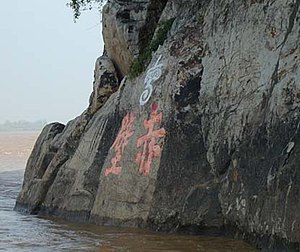Battle of Red Cliffs
| Battle of Red Cliffs | |||||||||
|---|---|---|---|---|---|---|---|---|---|
| Part of the wars at the end of the Han dynasty | |||||||||
 Engravings on a cliff-side mark one widely accepted site of Chibi, near present-day Chibi City, Hubei. The engravings are at least a thousand years old. |
|||||||||
|
|||||||||
| Belligerents | |||||||||
|
Sun Quan, Liu Bei |
Cao Cao | ||||||||
| Commanders and leaders | |||||||||
|
Zhou Yu, Cheng Pu, Liu Bei |
Cao Cao | ||||||||
| Strength | |||||||||
| 50,000 | 800,000 (Cao Cao's claim) 220,000–240,000 (Zhou Yu's estimate) |
||||||||
| Casualties and losses | |||||||||
| Unknown | Unknown, though described as significant | ||||||||
| Battle of Red Cliffs | |||||||||||||||||
| Traditional Chinese | 赤壁之戰 | ||||||||||||||||
|---|---|---|---|---|---|---|---|---|---|---|---|---|---|---|---|---|---|
| Simplified Chinese | 赤壁之战 | ||||||||||||||||
|
|||||||||||||||||
| Transcriptions | |
|---|---|
| Standard Mandarin | |
| Hanyu Pinyin | Chìbì zhī zhàn |
| IPA | [ʈʂʰɨ̂.pî ʈʂɨ́ ʈʂân] |
| Yue: Cantonese | |
| Jyutping | Cek3-bik1 zi1 zin3 |
| Southern Min | |
| Hokkien POJ | Chhek-pek chi chiàn |
The Battle of Red Cliffs, otherwise known as the Battle of Chibi, was a decisive battle fought at the end of the Han dynasty, about twelve years prior to the beginning of the Three Kingdoms period in Chinese history. It was fought in the winter of AD 208/9 between the allied forces of the southern warlords Liu Bei and Sun Quan and the numerically superior forces of the northern warlord Cao Cao. Liu Bei and Sun Quan successfully frustrated Cao Cao's effort to conquer the land south of the Yangtze River and reunite the territory of the Eastern Han dynasty. The allied victory at Red Cliffs ensured the survival of Liu Bei and Sun Quan, gave them control of the Yangtze (de Crespigny 1990:273), and provided a line of defence that was the basis for the later creation of the two southern states of Shu Han and Eastern Wu. The battle has been called the largest naval battle in history in terms of numbers involved.
Descriptions of the battle differ widely, and the location of the battle is fiercely debated (de Crespigny 1990:256 78n). Although its precise location remains uncertain, the majority of academic conjectures place it on the south bank of the Yangtze River, southwest of present-day Wuhan and northeast of Baqiu (present-day Yueyang, Hunan).
By the early third century, the Han dynasty, which had ruled China for almost four centuries (albeit with a 16-year interruption, dividing the dynasty into its Western and Eastern periods), was crumbling. Emperor Xian had been a political figurehead since 189, with no control over the actions of the various warlords controlling their respective territories. One of the most powerful warlords in China was Cao Cao, who, by 207, had unified northern China and retained total control of the North China Plain. He then completed a successful campaign against the Wuhuan in the winter of the same year, thus securing his northern frontier. Upon his return in 208, he was appointed Chancellor, a position that granted him absolute authority over the entire imperial government (de Crespigny 1969:253, 465 6n). Shortly afterwards, in the autumn of 208, his army began a southern campaign (Eikenberry 1994; de Crespigny 2003).
...
Wikipedia
